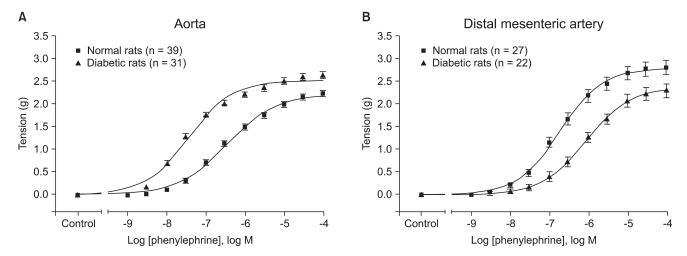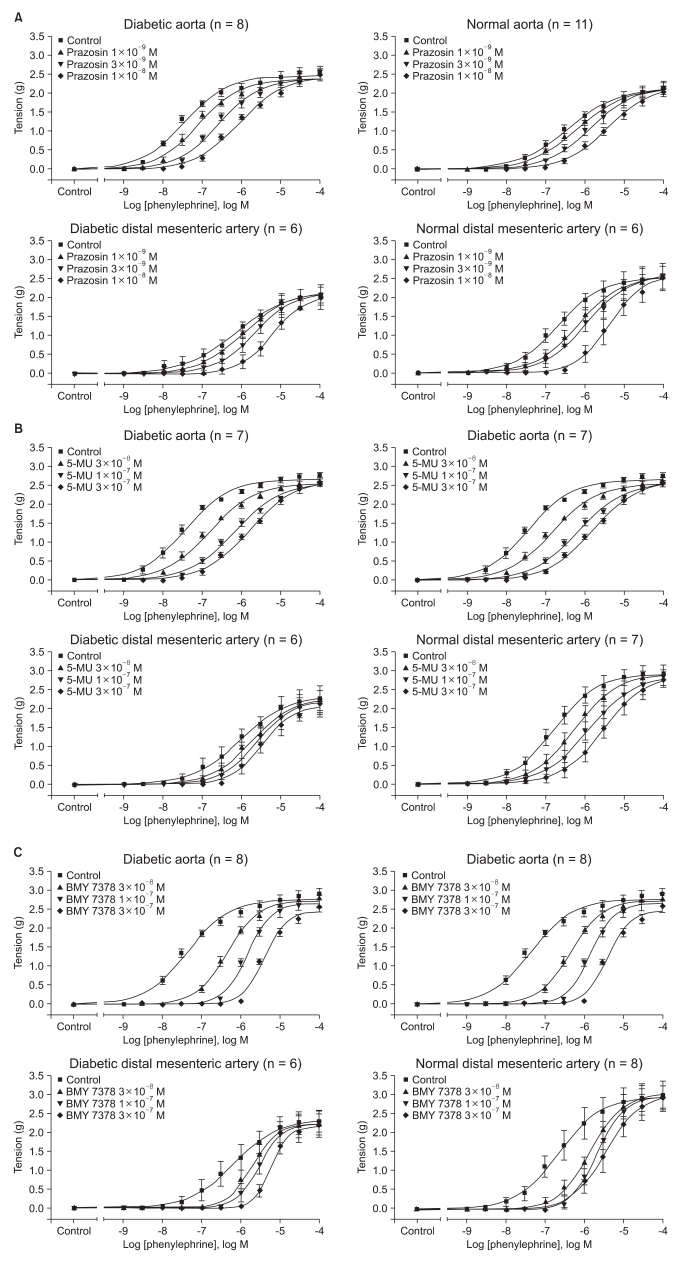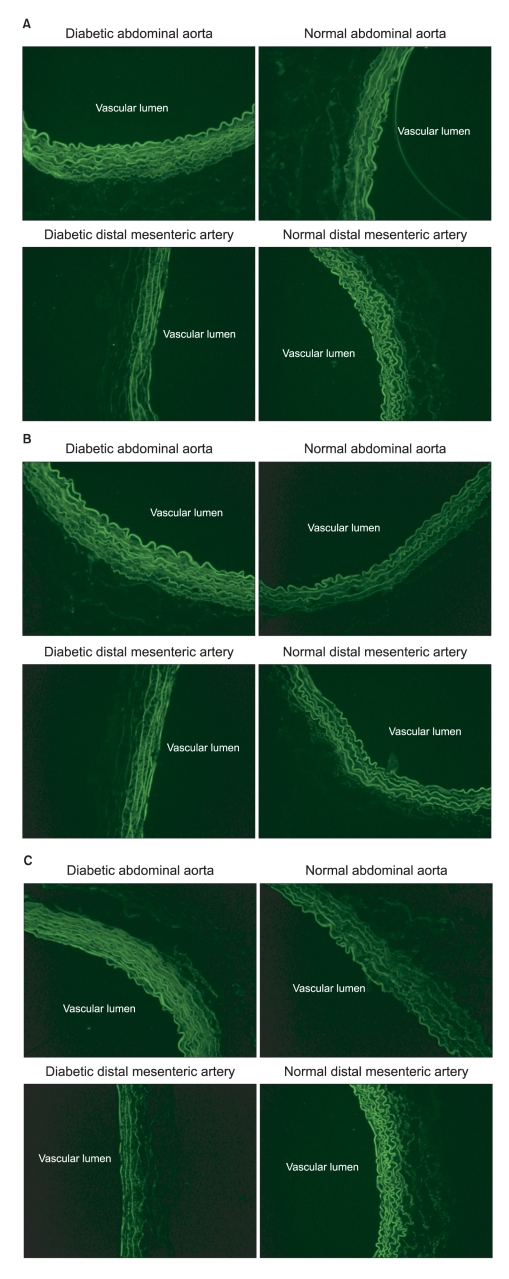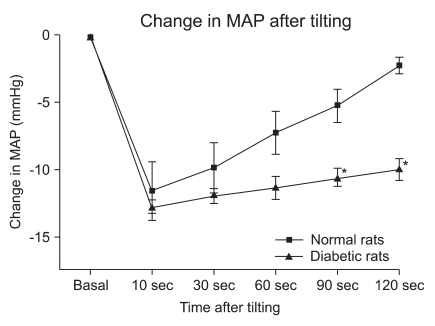1. Amos AF, McCarty DJ, Zimmet P. The rising global burden of diabetes and its complications: estimates and projections to the year 2010. Diabet Med. 1997; 14(Suppl 5):S1–S85. PMID:
9450510.

2. Watkins PJ, Thomas PK. Diabetes mellitus and the nervous system. J Neurol Neurosurg Psychiatry. 1998; 65:620–632. PMID:
9810929.

3. Vinik Al, Maser RE, Mitchell BD, Freeman R. Diabetic autonomic neouropathy. Diabetes Care. 2003; 26:1553–1579. PMID:
12716821.
4. Edmonds ME, Morrison N, Laws JW, Watkins PJ. Medial arterial calcification and diabetic neuropathy. Br Med J (Clin Res Ed). 1982; 284:928–930.

5. Flynn MD, Tooke JE. Diabetic neuropathy and the microcirculation. Diabet Med. 1995; 12:298–301. PMID:
7600742.

6. Burgos LG, Elbert TJ, Asiddao C, Turner LA, Pattison CZ, Wang-Cheng R, et al. Increase intraoperative cardiovascular morbidity in diabetics with autonomic neuropathy. Anesthesiology. 1989; 70:591–597. PMID:
2929996.
7. Langer SZ, Hicks PE. Alpha-adrenoceptor subtypes in blood vessels: physiology and pharmacology. J Cardiovasc Pharmacol. 1984; 6(Suppl 4):S547–S558. PMID:
6210422.

8. Ruffolo RR Jr, Hieble JP, Brooks DP, Feurstein GZ, Nichols AJ. Drug receptors and control of the cardiovascular system: recent advances. Prog Drug Res. 1991; 36:117–360. PMID:
1876708.

9. Jarajapu YP, Coats P, McGrath JC, Hiller C, MacDonald A. Functional characterization of alpha(1)-adrenoceptor subtypes in human skeletal muscle resistance arteries. Br J Pharmacol. 2001; 133:679–686. PMID:
11429392.
10. Vargas HM, Gorman AJ. Vascular alpha-1 adrenergic receptor subtypes in the regulation of arterial pressure. Life Sci. 1995; 57:2291–2308. PMID:
7491088.

11. Koshimizu TA, Tanoue A, Hirasawa A, Yamauchi J, Tsujimoto G. Recent advances in alpha 1-adrenoceptor pharmacology. Pharmacol Ther. 2003; 98:235–244. PMID:
12725871.
12. Civantos Calzada B, Aleixandre de Artiñano A. Alpha-adrenoceptor subtypes. Pharmacol Res. 2001; 44:195–208. PMID:
11529686.

13. Agrawal DK, McNeill JH. Effect of diabetes on vascular smooth muscle function in normotensive and spontaneously hypertensive rat mesenteric artery. Can J Physiol Pharmacol. 1987; 65:2274–2280. PMID:
3449189.

14. Kam KL, Hendriks MG, Piji AJ, van Marle J, van Veen HA, Pfaffendorf M, et al. Contractile responses to various stimuli in isolated resistance vessels from simultaneously hypertensive and streptozotocin-diabetic rats. J Cardiovasc Pharmacol. 1996; 27:167–175. PMID:
8656652.

15. Beenen OH, Mathy MJ, Pfaffendorf M, van Zwieten PA. Vascular responsiveness in isolated perfused kidneys of diabetic hypertensive rats. J Hypertens. 1996; 14:1125–1130. PMID:
8986914.

16. Schild HO. pA, a new scale for the measurement of drug antagonism. Br J Pharmacol Chemother. 1947; 2:189–206. PMID:
20258355.

17. McGrath JC. Evidence for more than one type of post-junctional alpha-adrenoceptor. Biochem Pharmacol. 1982; 31:467–484. PMID:
6279105.
18. Arévalo-León LE, Gallardo-Ortíz IA, Urquiza-Marín H, Villalobos-Molina R. Evidence for the role of alpha1D- and alpha1A-adrenoceptors in contraction of the rat mesenteric artery. Vascul Pharmacol. 2003; 40:91–96. PMID:
12646397.
19. Martí D, Miquel R, Ziani K, Gisbert R, Ivorra MD, Anselmi E, et al. Correlation between mRNA levels and functional role of alpha1-adrenoceptor subtypes in arteries: evidence of alpha1L as a functional isoform of the alpha1A-adrenoceptor. Am J Physiol Heart Circ Physiol. 2005; 289:H1923–H1932. PMID:
15951348.
20. Asbún-Bojalil J, Castillo EF, Escalante BA, Castillo C. Does segmental difference in alpha 1-adrenoceptor subtype explain contractile difference in rat abdominal and thoracic aortae? Vascul Pharmacol. 2002; 38:169–175. PMID:
12402516.
21. Wong KK. A significant increase of aortic response to a combination of norepinephrine and KCl in aorta isolated from 2-month diabetic rats induced by streptozotocin. Artery. 1996; 22:164–171. PMID:
8893974.
22. Mahmoudian M, Benhaz F, Rezaei E. Diabetes-induced changes in the contractility of the aorta and pA2 of nifedipine in the rat. Acta Diabetol. 1996; 33:114–117. PMID:
8870812.

23. Nobe K, Sakai Y, Maruyama Y, Momose K. Hyper-reactivity of diacylglycerol kinase is involved in the dysfunction of aortic smooth muscle contractility in streptozotocin-induced diabetic rats. Br J Pharmacol. 2002; 136:441–451. PMID:
12023947.

24. Schulingkamp RJ, Vincent A, Tallarida RJ, Raffa RB. Changes in aorta alpha1-adrenoceptor number and affinity during one year of streptozotocin-induced diabetes in rats. Pharmacology. 2005; 74:23–30. PMID:
15640611.
25. Abebe W, Harris KH, MacLeod KM. Enhanced contractile responses of arteries from diabetic rats to alpha 1-adrenoceptor stimulation in the absence and presence of extracellular calcium. J Cardiovasc Pharmacol. 1990; 16:239–248. PMID:
1697380.
26. Abebe W, MacLeod KM. Enhanced arterial contractility to noradrenaline in diabetic rats is associated with phosphoinositide metabolism. Can J Physiol Pharmacol. 1991; 69:355–361. PMID:
1647847.
27. Wong KK. A significant increase of aortic response to a combination of norepinephrine and KCl in aorta isolated from 2-month diabetic rats induced by streptozotocin. Artery. 1996; 22:164–171. PMID:
8893974.
28. Brøndum E, Nilsson H, Aalkjaer C. Functional abnormalities in isolated arteries from Goto-Kakizaki and Streptozotocin-treated diabetic rat models. Horm Metab Res. 2005; 37(Suppl 1):56–60.

29. Makino A, Kamata K. Possible modulation by endothelin-1, nitric oxide, prostaglandin 12 and thromboxane A2 of vasoconstriction induced by an alpha-agonist in mesenteric arterial bed from diabetic rats. Diabetologia. 1998; 41:1410–1418. PMID:
9867207.
30. Jensen BC, Swigart PM, Simpson PC. Ten commercial antibodies for alpha-1-adrenergic receptor subtypes are nonspecific. Naunyn Schmiedebergs Arch Pharmacol. 2009; 379:409–412. PMID:
18989658.









 PDF
PDF Citation
Citation Print
Print




 XML Download
XML Download